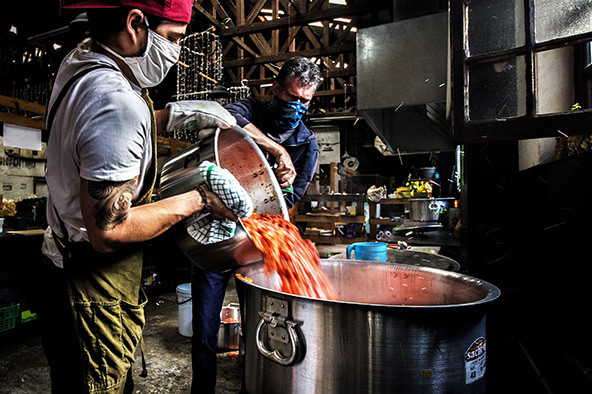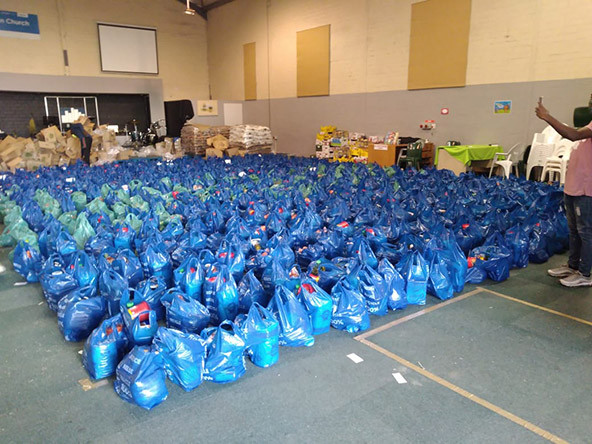 Muizenberg CAN volunteers work in the Muizenberg community kitchen, temporarily housed at the Blue Bird Market, a local goods market. (Photo by Patrick McKenna)
Muizenberg CAN volunteers work in the Muizenberg community kitchen, temporarily housed at the Blue Bird Market, a local goods market. (Photo by Patrick McKenna)
Civil society responses to COVID-19 in South Africa have shown remarkable agility, scope, and impact in the last nine months, especially in responding to the most-pressing problem in many vulnerable communities: hunger. These have included efforts by established nonprofits, as well as diverse mutual-aid groups like the community action networks (CANs) that spontaneously emerged in suburbs of Cape Town and then spread to other parts of the country. The individual CANs collaborate and support each other within a larger network called Cape Town Together. Interactions include “pairing” partnerships, in which a CAN in an affluent suburb collaborates with a CAN in a poor community, not to facilitate charity, but rather to foster solidarity across historically divided and profoundly unequal suburb communities. The impact has been significant and vital, with estimates suggesting that NGOs and mutual-aid groups provided more than half of all hunger relief during South Africa’s winter months.
However, these civil society efforts are now facing new challenges. Hunger is not diminishing in poor communities, despite an erstwhile end to lockdown and an increase in social grants. Meanwhile, these groups are contending with shrinking resources, as donations dry up and many volunteers go back to their normal routines or try to.

In that context, it’s impressive how many of these initiatives are showing significant resilience and continuing to provide much-needed food relief. It’s also significant that many are simultaneously reinventing themselves to foster longer-term, positive change. In so doing, they are offering inspiring examples of social innovation born from crisis, resisting the all-too-common return to pre-crisis “normal.” These social innovation processes are taking diverse forms and responding to varying contexts, yet five themes feature prominently across many of them and are likely salient in other contexts.
1. A Shift From Volunteering to “Social Entrepreneuring”
As hunger became increasingly evident and widespread in the early weeks of the pandemic, activists—mostly volunteers—made it possible to spontaneously organize food relief with speed, agility, and impact. For example, one activist recognized immediately that the lockdown would create severe distress in a poor community she had been working in and set to work. She explained, “Within 30 minutes, I had created a quick graphic explaining the need and sent it to a broadcast list of friends … Three days later, we distributed 100 boxes with 21 days’ worth of children’s activities, some basic food supplies, and some health products to 100 families.” Another activist spoke of the “emergency feeling” that motivated this generosity, created a unifying purpose, and fostered profound cooperativeness.
Some volunteers continue to show remarkable generosity, but most can’t continue working for free, especially with the long term in mind. Many civil society responses are thus exploring ways to provide income to at least some of their activists. For example, the community kitchen established by the CAN in Muizenberg, a seaside suburb in south Cape Town, is asking for small payments from patrons who can afford it and has set up a food stall at a popular night market, among other fundraising efforts, to pay stipends to its core team of kitchen volunteers. Similarly, some of the community kitchens in the township of Khayelitsha may use equipment they received for the hunger relief effort through their partnership with the Constantia CAN to open up small restaurants. The income could enable them to continue feeding vulnerable community members.
Volunteers have also played an important role in setting up novel intermediary organizations to connect food supply and demand, and are exploring new models to remain viable as donations dry up. In the very early days of the crisis, for example, demand for produce from small farms collapsed, as restaurants and other customers closed during lockdown; farmers were struggling to sell their produce even while hunger gripped poor communities. A new nonprofit organization, FoodFlow, launched to address the issue by using donations to purchase produce from small farmers and then pass it on to organizations that distribute food to communities. In this way, it created an entirely new supply chain that connects small, poor farmers with vulnerable communities in need of food.
 Farmer supported by FoodFlow carries a harvest of beans in Limpopo. (Photo by Thanyani Ramarumo)
Farmer supported by FoodFlow carries a harvest of beans in Limpopo. (Photo by Thanyani Ramarumo)
But FoodFlow’s model relies on donations, which started diminishing mid-year. It’s kept going thanks to a few larger grants from philanthropic organizations, but in the meantime, this organization is looking to shift to a more market-based approach. By leveraging the networks it’s created during the crisis and cutting costs, it could provide a more efficient and cheaper conduit between local farmers and small food vendors in poor communities than existing supply chains.
It will be interesting to see whether and how initiatives like these can augment, or even shift away from, their current reliance on volunteering and donations to social entrepreneurial models based on market transactions.
2. A Solidarity Economy Built Around Local Food Value Chains
It’s important to note that market transactions like the ones above wouldn’t occur in just any market, or in an anonymous, global market increasingly dominated by large corporations. Civil society activists are envisioning markets that include more local value chains, characterized by solidarity and resilience as guiding principles, not just efficiency and competition.
Civil society groups are reconfiguring elements of their crisis response with this vision in mind. The Gugulethu CAN, for example, helped establish and supported a number of community kitchens in this mostly poor suburb of Cape Town, and some of them plan to continue operating longer-term. At the same time, the CAN has been creating a vibrant network of food gardens that both supply produce to the community kitchens and sell to the market to raise funds. The latter is supported by the Gugulethu CAN’s partnership with the CAN in Seaboard, a wealthier suburb, which is helping create customers. These kinds of food supply chains, localized by means of market transactions, are premised on not only efficiency, but also solidarity.
 Food parcels being packed in a repurposed church hall by Boost Africa. (Photo by Christine Fyvie)
Food parcels being packed in a repurposed church hall by Boost Africa. (Photo by Christine Fyvie)
The government and larger, established organizations also recognize the need to build local, resilient food systems. For example, the Western Cape Economic Development Partnership—a nonprofit bringing together government, business, and civil society—is using funding from the Western Cape Government and a private donor to transfer bi-monthly digital vouchers to 225 community kitchens, on the condition that the kitchens purchase their produce from small, local vendors, wholesalers, and informal traders in the townships, rather than the large formal retailers.
3. Developing and Using Local Knowledge and Partnerships
In establishing local solidarity economies, civil society activists are also seeking to make use of, and further enhance, two important resources developed during the crisis response. The first is local knowledge. Many activists responded to the emerging hunger crisis in late March and early April by organizing community mapping and household surveys. This helped them identify which households needed the most help, as well as what human and other resources were available in the community to address the growing need. This information has become a valuable resource in its own right. In the Eastern Cape village of Chintsa, for example, activists used the data from their door-to-door household survey to successfully lobby the provincial health department and secure more resources for the community.
The second vital resource is increasingly dense and broad social networks. These networks enabled the exchange of diverse resources within vulnerable communities, and between vulnerable communities and wealthier suburbs. For example, in Vrygrond, a poor suburb near Muizenberg, a group of entrepreneurial youths came together to organize food relief efforts during the crisis with support from the Muizenberg CAN and the nonprofit Amava Oluntu. This group is now actively working on a broader range of community-development projects, including a project to combat gender-based violence in the community, supported by grant funding. Amava Oluntu has played an important role in nurturing, mentoring, and administratively supporting the young activists, as well as fostering their networks beyond the community.
Civil society groups are now proactively building on these local knowledge resources and networks with the longer-term in mind. For example, activists, academics, and company managers established a collaboration platform in Stellenbosch (a town near Cape Town) to map the local food system in that area, with the aim of finding ways different resources and competencies can come together to make the system fairer and more resilient. As one collaborator explained, “What would a new food system look like [in this town]? Who has land, seeds, [and] skills, and how do we bring all of that to the table? We set a common agenda, and we say, ‘What is your role to further that common agenda?’”
Efforts like these are bringing innovative and locally appropriate knowledge to bear. In one example, the founder of nonprofit Umgibe, Nonhlanhla Joye, developed a locally appropriate farming technique using plastic bags, and the COVID-19 crisis has demonstrated to a larger number of farmers the benefits of both Umgibe’s farming methods and its approach to managing cooperatives. Umgibe now supports about 150 food cooperatives, each comprised of five or six small-scale farmers.
Another nonprofit, Ubunye, has grappled with the effects of both COVID-19 and a severe drought in South Africa’s Eastern Cape province for two years. In recent months, it contributed to the development of an innovative farming approach using tower vegetable gardens, which make efficient use of graywater and which farmers can easily construct using readily available materials. Ubunye’s networks grew rapidly as part of the civil society response to COVID-19 and have helped spread other homegrown innovations in farming.
4. An Evolving Ecosystem of Social Innovation Networks
The strengthening of established networks and the emergence of novel connections has included networks within communities, which social scientists sometimes refer to as “bonding social capital.” It has also included connections between different communities (“bridging social capital”) and between communities and influential institutions like government (“linking social capital”).
The COVID-19 response has thus contributed to a stronger ecosystem of civil society groups, in which different groups play different yet complementary roles. One reason this is turning out to be important relates to the relationship between emergent, informal groups and more-formal organizational structures. Activists in the CANs and other spontaneously created groups have frequently emphasized the importance of their non-hierarchical, emergent, and flexible organizational structures, as they allowed them to be responsive to different local contexts and rapidly changing circumstances. Yet, as the pandemic has evolved, some of these groups have considered registering as formal organizations in order to gain access to grants from larger civil society organizations, government agencies, and other funding sources that require registration and formal accountability mechanisms. Others have balked at the prospect, both because of the administrative burdens that attend registration and because it seems anathema to their flexible way of working.
But a promising, in-between model is emerging, in which community groups partner with established, registered organizations. The community groups gain many of the benefits of formal administration and accountability, while maintaining their flexibility and non-hierarchical way of operating. The nonprofits meanwhile gain diverse knowledge, networks, and other resources that support their mission. In addition to working with Amava Oluntu to support vulnerable groups in Vrygrond, for example, the Muizenberg CAN is partnering with the nonprofit U-Turn to support the area’s homeless community.
There’s now an opportunity to scale this model to maintain at least some of the effective, community-level organizing galvanized by the COVID-19 hunger crisis. Diverse funders, including philanthropic organizations and the government, have recognized the role local organizing has played and could continue to play in hunger relief and in broader social innovation efforts. For example, the provincial government of the Western Cape has recently made 51 million rand (about $3.3 million) available to support nonprofit hunger relief efforts, with an explicit intention to involve community-based groups.
5. Engaging the State in Diverse Ways
Some of the interactions between new civil society groups and government have been complementary and supportive. For example, Cape Town Together developed information material on COVID-19 for dissemination in vulnerable communities, which provincial health officials adapted and distributed. Meanwhile, numerous activists received support from local government officials or councilors, and some state employees or their family members joined activist efforts. In another example, the Western Cape NGO-Government Food Relief Coordination Forum sought to strengthen relationships between civil society and government in their crisis response.
Unfortunately, much of this collaborative spirit and interconnectedness diminished as time went on. Some politicians or officials disagreed with or felt threatened by the strategies or actions of civil society groups. In one case, a local councilor thwarted the efforts of CAN activists to set up a community-based isolation center for people infected with COVID-19—an action that caused controversy in the national media. Civil society groups have also been at odds with local governments in resisting evictions.
But while space for cooperation is closing down in many places, the interpersonal relationships between civil society activists and state employees that joined their efforts hold promise for longer-term collaboration. Meanwhile, some civil society groups that formed during the crisis are contemplating direct political engagement, arguing they showed the kind of public leadership and engagement communities needed to cope with the pandemic. Some activists are considering running for local office, either as independents or even as part of a new political party. Others see their role as fostering stronger state accountability; they see inspiration, for example, in the court case brought by civil society organizations mid-year, which forced the government to recommence its provision of daily meals to primary- and secondary- school kids, a program that closed down during the lockdown.
These diverse approaches to engagement, fostered by the broader ecosystem of civil society activists emerging from the crisis, are promoting state accountability.
Conclusion
Researchers studying civil society responses to disasters have celebrated their spontaneous agility and solidarity, but they have often seen “cooperative, life-affirming social experiments disappear when established institutions of governance and patterns of social behavior eventually return.” Many civil society responses to COVID-19 in South Africa are proactively resisting a return to pre-crisis “normal.” These efforts deserve support, and will no doubt shape how we engage in and think about social innovation in years to come.
Despite their diversity, these agile civil society groups have much to learn from each other, both within and beyond South Africa. They can draw inspiration from initiatives transitioning to a more entrepreneurial approach, or seeking to make food supply chains more inclusive and resilient. They can also proactively leverage and further expand their networks to broaden the social innovation ecosystem, in which different activists’ roles and strengths complement each other. Funders, governments, and academics can also support this mutual sharing, experimentation, and innovation, which have been a hallmark of civil society responses to the COVID-19 crisis.
Support SSIR’s coverage of cross-sector solutions to global challenges.
Help us further the reach of innovative ideas. Donate today.
Read more stories by Ralph Hamann, Jenny Soderbergh, Annika Surmeier, Christine Fyvie, Thanyani Ramarumo, Mandy Rapson, Nadia Sitas & Ashley Newell.

